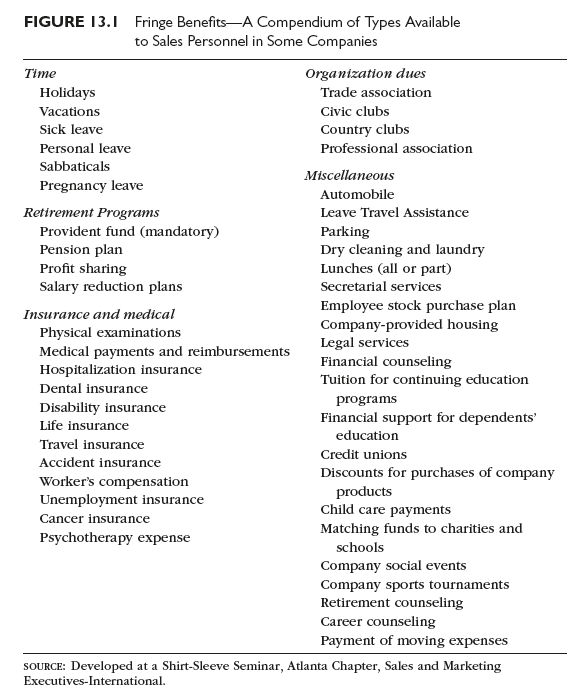Fringe benefits, which do not bear direct relationships to job performance, range from 25 to 40 percent of the total sales compensation package. Some are required by federal and state law—for example, payments for social security premiums, unemployment compensation, and worker’s compensation. Most, however, the company provides for other reasons: to be competitive with other companies in the industry or community, to furnish reasons for employees to remain in the company’s service, and to comply with what employees expect as fringe benefits.
Fringe benefits, like monetary compensation, are not motivating factors. In the Maslow hierarchy, fringe benefits contribute to fulfillment of safety and security needs, although some (such as payment of country club dues) contribute to fulfillment of esteem and other higher-order needs. Since fringe benefits are given to all in the company’s employ and do not vary with job performance, they help to prevent job dissatisfaction but do not add to job satisfaction (in line with Herzberg’s motivation- hygiene theory).
Figure 13.1 shows fringe benefits currently offered by U.S. companies. As the variety of fringes has expanded, individual fringes have been added that appeal more to some groups than others—people with bad teeth are the ones most interested in dental insurance, while those with children are the ones most interested in plans for paying educational tuition fees for dependents. Similarly, given a choice between supplemental life insurance and increased retirement benefits from the savings plan, a fifty-nine-year-old probably would pick the latter, but a thirty-two-year-old father of five might opt for the life insurance.
An increasing number of companies offer a “cafeteria” approach to fringe benefits. In this approach, the company offers a core of basic benefits— the benefits required by law plus other traditional benefits, including paid vacations, medical, disability, and death benefits and a retirement program. Employees then use credits (based on age, pay, family status, and years of company service) to obtain optional benefits not included in the core; this lets employees select those benefits that best fit their needs. Because needs for benefits change, employees are given opportunities to change their selection of those benefits that best fit their needs. Because needs for benefits change, employees are given opportunities to change their selections. Companies using the cafeteria approach also have “awareness programs” aimed at making employees aware of the benefits available.

Source: Richard R. Still, Edward W. Cundliff, Normal A. P Govoni, Sandeep Puri (2017), Sales and Distribution Management: Decisions, Strategies, and Cases, Pearson; Sixth edition.

I dugg some of you post as I thought they were very useful handy
I like what you guys are up too. Such clever work and reporting! Carry on the superb works guys I?¦ve incorporated you guys to my blogroll. I think it will improve the value of my web site 🙂